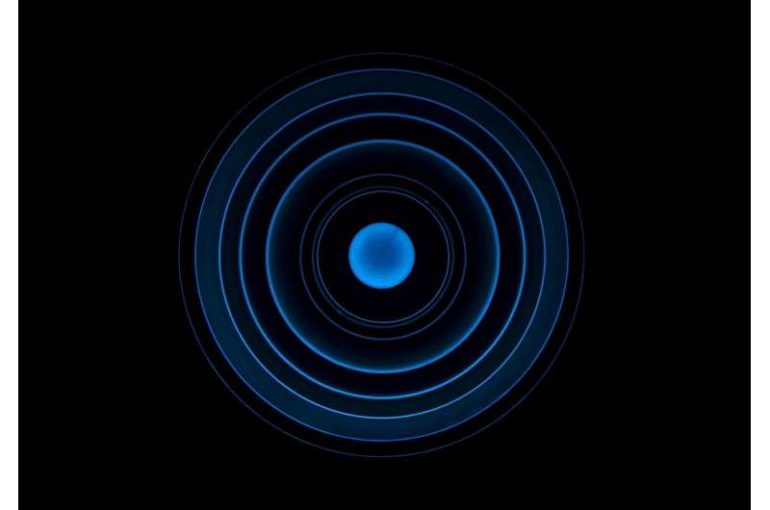Sensors that can detect magnetic fields have many potential applications, for instance, in the development of sophisticated medical devices and transportation systems. Most approaches for detecting 3D magnetic fields developed so far, however, require several sensors, which makes them bulky and difficult to implement on a large-scale.
With this in mind, researchers at the Nanoscale Energy-Efficient Device and System (NEEDS) Lab at Huazhong University of Science and Technology in China set out to develop a single spin-orbit device that can individually detect 3D magnetic fields. The device they designed, presented in a paper published in Nature Electronics and inspired by their previous work, is based on a Ta/CoFeB/MgO (tantalum/cobalt-iron-boron/magnesium oxide) heterostructure.
“One of our past papers, published in IEEE IEDM in 2018, reported that increasing writing current densities can gradually reduce the coercivity of a magnet until it reaches zero,” Long You, one of the researchers who carried out the study, told TechXplore. “Subsequently, in two papers published in AEM and APL we proposed that the current and in-plane field have a continuous regulation on the AHE resistance of the device through domain wall motion. Based on these previous works, we set out to detect a three-dimensional (3D) magnetic field with spin–orbit-torque (SOT) devices.”
A commonly employed approach for sensing 3D magnetic fields relies on the use of three magnetic sensors, with their sensing directions strategically arranged along three coordinate axes (x, y and z). Alternatively, some researchers employed so-called planar sensors with a magnetic flux guide attached to them.
In their work, You and his colleagues explored the possibility of detecting a vector magnetic field using a single spin-orbit torque device. The Ta/CoFeB/MgO heterostructure they designed achieves this via the displacement of domain walls in the CoFeB layer, which enables the modulation of what is known as the anomalous Hall effect resistance.
“According to the different symmetrical characters of current-polarity-dependent driving magnetization dynamic or switching, we separate the contributions of the in-plane (IP) and out-of-plane (OOP) fields and implement a 3D magnetic field sensing using a simple method,” You said. “We first set up the relationship between the AHE resistance and Hx, Hy, Hz based on the symmetry characters of R-H curves by applying positive and negative currents.”
A vector magnetic field is made up of two IP field components (i.e., Hx or Hy) and one OOP field component (Hz). These three elements can lead to different domain wall (DW) motions in the CoFeB layer when positive and negative currents are applied utilizing a spin-orbit torque (SOT), which ultimately leads to the modulation of the associated AHE resistance.
You and his colleagues derived the relationships between the measured AHE resistance and the vector magnetic field’s three orthogonal components. Their analyses showed that at certain ranges, these relationships are linear. Subsequently, they used the different symmetrical characters of current/polarity-dependent DW motions to separate the contributions of IP and OOP fields. This ultimately allowed them to achieve 3D magnetic field sensing using a single SOT device.
The sensing device developed by You and his colleague has a linear range between −10 and +10 Oe for the IP field, and between −4 and +4 Oe for the OOP field. Based on the symmetry characters of R-H curves under positive and negative currents, the researchers were able to collect two AHE resistance values under positive and negative current densities in the x axis, which they called Rxy (+Jx) and Rxy (−Jx).”
“If these two AHE resistance values are processed with a subtraction operation, enabling the elimination of Hz contribution, the net resistance contributed by only Hx component can be obtained,” You explained. “If the two values are processed with an adding operation, the net resistance contributed by only Hz component can be obtained. Similarly, we can get the net resistance contributed by only Hy component by applying ±Jy. Accordingly, one can know the magnitude and direction of the vector magnetic field by composing (Hx, Hy, Hz).”
You and his colleagues showed that there is a correlation between a linear DW displacement and the magnetic field that their device measured under an assisted constant current. This specific phenomenon, which was rarely investigated in the past, played a key role in their realization of a single 3D vector magnetic sensor.
“Our device physically separates the contributions of its three components to achieve single-device detection of the vector magnetic field, thus the fact that the three magnetic field components measured are not orthogonal or are not in the same spatial position does not impair its performance,” You said. “To the best of our knowledge, it is the first time someone realizes a 3D vector magnetic sensor using a single device, which has been a challenge faced in both academic settings and the electronics industry.”
The simple structure and innovative design proposed by You and his colleagues could have many interesting applications. With conventional transistor technologies approaching their physical limits, new technologies such as the device developed by these researchers could be of great value, as they could open up new possibilities for the development of faster and better performing devices.
“Tremendous efforts have been devoted in this field, which have enabled integrations of sensors, MEMS, optoelectronics, RF and mm-wave devices,” You said. “Our proposed 3D sensor based on the spintronic technology can be easily integrated into the Si-based chip, compared with conventional approaches that utilize three or more devices.”
The study could inform the development of new spintronic devices and integrated circuits. In addition, the 3D magnetic field sensor they created could have a broad range of applications, for instance enabling the creation of new IoT and GPS devices.
“In the future, we are going to replace the AHE heterostructure structures with MTJ structures,” You said. “Moreover, we are designing and building a peripheral circuit system and designing a suitable algorithm so that our device can be used in practical applications, such as in navigation and positioning or in heterogeneous integration technology and neural networks .”
Microwave-assisted recording technology promises high-density hard disk performance
More information:
A spin-orbit torque device for sensing three-dimensional magnetic fields. Nature Electronics(2021). DOI: 10.1038/s41928-021-00542-8
Spin-orbit-torque-driven multilevel switching in Ta/CoFeB/MgO structures without initialization. Applied Physics Letters(2019). DOI: 10.1063/1.5079313
2021 Science X Network
Citation:
A single spin-orbit torque device to sense 3D magnetic fields (2021, April 9)
retrieved 10 April 2021
from https://techxplore.com/news/2021-04-spin-orbit-torque-device-3d-magnetic.html
This document is subject to copyright. Apart from any fair dealing for the purpose of private study or research, no
part may be reproduced without the written permission. The content is provided for information purposes only.



